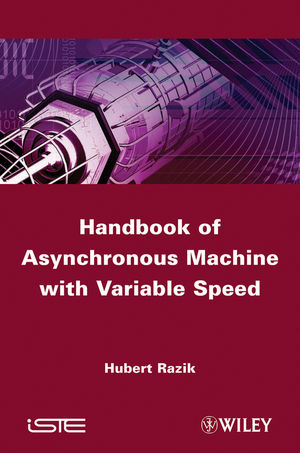
Handbook of Asynchronous Machines with Variable Speed
ISTE Ltd and John Wiley & Sons Inc (Verlag)
978-1-84821-225-1 (ISBN)
Hubert Razik, Nancy-Université Henri Poincaré, France.
Foreword xiii
Introduction xvii
Chapter 1. Sensors and Electrical Measurements 1
1.1. Optical encoder 2
1.2.The velocity measurement 7
1.3. The resolver 9
1.4. The isolated measurement 14
1.5. The numerical aspect 15
1.6. The analog to digital converter 16
1.7. The digital-to-analog converter 21
1.8. The digital output 22
1.9. The arithmetic logic unit 22
1.10. Real time or abuse language 23
1.11. Programming 24
Chapter 2. Analog, Numerical Control 25
2.1. Structure of a regulator 25
2.2. Stability of a system 26
2.3. Precision of systems 30
2.4. Correction of systems 31
2.5. Nonlinear control 34
2.6. Practical method of identification and control 35
2.7. The digital correctors 36
2.8. Classical controllers 45
2.9. Disadvantages of digital controller 52
Chapter 3. Models of Asynchronous Machines 59
3.1. The induction motor 59
3.2. The squirrel cage induction motor 66
3.3. The static and dynamic behavior 82
3.4. Winding and induced harmonics 99
3.5. Squirrel cage 115
3.6. Variation in air-gap permeance 118
3.7. Noise and vibrations 121
3.8. Influence of rotor frequency 125
3.9. Thermal behavior 130
Chapter 4. Speed Variation 137
4.1. Cases of multiphase machines 137
4.2. Control of asynchronous motors 164
4.3. Identification of parameter aspects 216
4.4. Voltage inverter converters 227
4.5. Rectifiers based on thePWM 268
Chapter 5. Tools of Fuzzy Logic 273
5.1. Preamble 273
5.2. Introduction 274
5.3. Fuzzy logic 275
5.4. Fuzzy logic controller 280
5.5. Fuzzy and adaptive PI 284
5.6. Conclusion 295
Chapter 6. Diagnostics and Signals Pointing to a Change 297
6.1. Signals and measurements 298
6.2. Defects 299
6.3. Analysis of signals 309
6.4. Some considerations regarding broken bar defects 317
6.5.Evaluation of the severity of broken bars 322
Exercise No. 1: Fuzzy Logic 337
1.1. Adaptive k and ki coefficients in function of the error 337
1.2. Adaptive k and ki coefficients in function of the error and its derivative 338
1.3. Answers 339
Exercise No. 2: The Stator Defect 345
2.1. Equations of the induction motor under stator defect 347
2.2.Torque ripple due to a stator defect 348
2.3. Fault current estimation 349
2.4. Schematic model of three-phase induction motor under a stator defect 350
2.5. Answers 351
Exercise No. 3: The Control of Five-Phase Induction Motors 357
3.1. The five-phase system 358
3.2. Distribution of active currents 359
3.3. A model for control 362
3.4. Answers 364
Exercise No. 4: The Control of Serial Connected Induction Motors 373
4.1. Study about the serial connection of two five-phase induction motors 374
4.2. Study on the serial connection of several seven-phase induction motors 375
4.3. Study on the serial connection of multi-phase induction motors 377
4.4. Answers 378
Exercise No. 5: Fault Detection of a Three-Phase Voltage Inverter Converter 385
5.1. A conducting fault 386
5.2. Fault detector 387
5.3. Monitoring of the DC component 389
5.4. Answers 390
Appendix. Some Mathematical Expressions 393
Bibliography 399
Index 407
| Erscheint lt. Verlag | 8.3.2011 |
|---|---|
| Verlagsort | London |
| Sprache | englisch |
| Maße | 163 x 241 mm |
| Gewicht | 758 g |
| Themenwelt | Informatik ► Weitere Themen ► CAD-Programme |
| Naturwissenschaften ► Physik / Astronomie ► Elektrodynamik | |
| Technik ► Elektrotechnik / Energietechnik | |
| Technik ► Maschinenbau | |
| ISBN-10 | 1-84821-225-9 / 1848212259 |
| ISBN-13 | 978-1-84821-225-1 / 9781848212251 |
| Zustand | Neuware |
| Haben Sie eine Frage zum Produkt? |
aus dem Bereich


